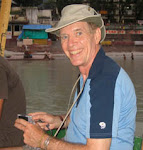 September 5 (continued): Shortly before we reach Gangotri, we pass a military base. It is a rambling encampment of buildings on both sides of the road. Soldiers walk alongside the road, or traverse their routes on motor scooters. Delivery vehicles of every sort site along the shoulders. At one point we observe that there is a helicopter. Only an observation.
September 5 (continued): Shortly before we reach Gangotri, we pass a military base. It is a rambling encampment of buildings on both sides of the road. Soldiers walk alongside the road, or traverse their routes on motor scooters. Delivery vehicles of every sort site along the shoulders. At one point we observe that there is a helicopter. Only an observation.Gangotri is the last village accessible by road as you travel toward the headwaters of the Ganga. Some say that at one time it sat at the snout of the glacier that becomes the Ganga River. Today it is several miles below the glacier. Arriving, you immediately notice that it differs in some ways from the many other villages that we have experienced. Gangotri greets you with a gate, the town dump, and a parking lot. The gate is old and concrete, straddling the road. It is chipped, the paint faded. The dump, which is smoldering, is evidently also home to some of the town residents.
Our drivers adroitly thread the cars into parking spaces where they are to remain for several days. We are assured that we can leave anything that we won’t need in the cars. I find myself leaving behind much of what I once thought indispensible. It is no longer indispensible, and I trust that it will be there on my return. I am learning what is important. I am learning India.
It is late afternoon. We will not be able to trek today. Instead, we walk up the road in Gangotri to the guesthouse that is expecting our stay to begin in another three nights. They are able to accommodate us. We go into a restaurant, and up a flight of stairs, emerging on a terrace. There is some concern about the rooms that are first shown to us, and we are offered others further up. However, in this case, further up turns out to be a bit treacherous. We walk/climb up along the broken top of a wall that is six inches wide to reach the next level. From there, we go up another level along an inclined sidewalk. Later we will find the stairs that go from the street level. They are outside the restaurant, and offer their own challenges. Some of the steps are eighteen inches or more in height.
Gangotri is an unexpected treat. Tonight we will get to visit the temple at sundown, to shop for woolen hats and gloves (which we will need in the next few days), to eat in a restaurant, to pour warm water over ourselves as we shower, and to sleep in a bed. Each room has a small balcony overlooking Gangotri, the Ganga, and the river valley. I spend time marveling at the beauty, and taking pictures.
Tomorrow we leave for Vojbasa. The next day, we will go on to Topovan. At 14,600 feet, this will truly be the peak experience of the trek.














